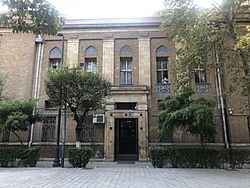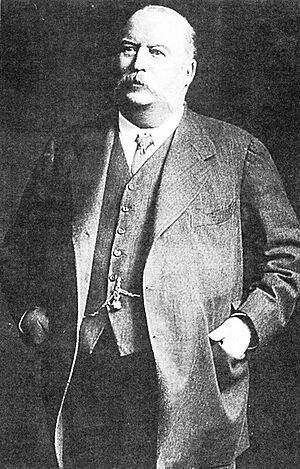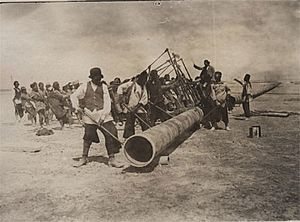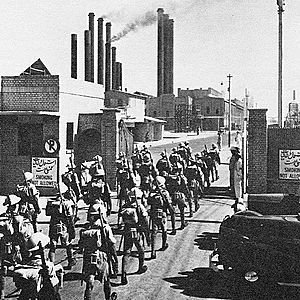Anglo-Persian Oil Company facts for kids
Quick facts for kids 
The former Anglo-Persian Oil Company (now Foreign Ministry No.3) building in Tehran
|
|
| Industry | Petroleum |
|---|---|
| Fate | Became "British Petroleum Company", assets nationalised by the Iranian government |
| Successor | National Iranian Oil Company BP |
| Founded | 14 April 1909 |
| Defunct | 16 December 1954 |
| Headquarters | , |
|
Area served
|
Iran |
| Products | Gasoline, motor oils |
The Anglo-Persian Oil Company (APOC) was a British company. It was started in 1909 after a huge oil field was found in Masjed Soleiman, Persia (now called Iran).
In 1914, the British government bought more than half of the company. This meant they had control over it. APOC was the first company to get petroleum from Iran. In 1935, its name changed to the "Anglo-Iranian Oil Company" (AIOC). This happened because Reza Shah Pahlavi asked other countries to use the name Iran instead of Persia.
In 1954, the company changed its name again to the "British Petroleum Company." This company is now known as BP. The government of Mohammad Mosaddegh in Iran took control of the company's oil facilities in Iran. They created a new company called the National Iranian Oil Company.
Contents
How the Oil Deal Started
Finding Oil in Persia
In 1901, William Knox D'Arcy, a rich man from London, made a deal with Mozaffar al-Din Shah Qajar, the ruler of Persia. This deal, called an oil concession, gave D'Arcy the special right to search for oil for 60 years. This right covered a very large part of Persia.
In return, the Shah received £20,000 and the same amount in shares of D'Arcy's company. He was also promised 16% of any future profits from the oil.
D'Arcy hired a geologist named George Bernard Reynolds to search for oil in the Persian desert. The conditions were very tough. There were diseases, bandits, and it was hard to find water. Temperatures often went above 50°C (122°F).
After several years, D'Arcy had spent a lot of money and still hadn't found oil. He had to sell most of his rights to a company called Burmah Oil Company. By 1908, D'Arcy and Burmah Oil had spent over £500,000. They decided to give up on finding oil in Persia. They sent Reynolds a message telling him to stop work and come home. But Reynolds waited a little longer. Luckily, he struck oil on May 26, 1908.
Starting the Anglo-Persian Oil Company
On April 14, 1909, Burmah Oil created the Anglo-Persian Oil Company (APOC). It was a new company under Burmah Oil. They also sold shares of APOC to the public.
Oil production began in 1913 from a refinery built in Abadan. For 50 years, this was the largest oil refinery in the world. In 1913, before World War I, APOC talked with a new customer: Winston Churchill. He was in charge of the British Royal Navy. Churchill wanted to modernize Britain's navy. He planned to switch from coal to oil to power ships. Oil was better because it gave ships more power and allowed them to travel further. Churchill also wanted Britain to rely less on other big oil companies.
So, the British government invested money into APOC. This gave them a controlling share in the company. This deal was set to last for 20 years. The British government then became a powerful force behind the oil company.
APOC also bought a share in another company called the Turkish Petroleum Company (TPC). This company was formed in 1912 to find oil in the Ottoman Empire (which included parts of modern-day Iraq). After World War I, TPC found a huge amount of oil in Kirkuk, Iraq, in 1927. It then changed its name to the Iraq Petroleum Company.
Over time, many people in Persia were unhappy with the D'Arcy oil deal. Persia only received 16% of the profits. The government felt it didn't have enough control over its own oil. This made them want to change the terms of the deal.
In 1923, Burmah Oil hired Winston Churchill as a consultant. He helped APOC get exclusive rights to Persian oil. Later, in 1928, APOC's share in the Iraq Petroleum Company was reduced. This was due to changes in the region after the Ottoman Empire broke up.
Changing the Oil Deal with Iran
From 1928 to 1932, Abdolhossein Teymourtash, a minister in Persia, tried to change the oil deal. He negotiated with John Cadman, the head of APOC. Persia argued that the original deal from 1901 was unfair. It was made when the government was not strong.
Persia wanted 25% of APOC's total shares. Teymourtash said that if it were a new deal, Persia would ask for 50%. He also asked for a guaranteed minimum payment of 12.5% from the company's profits. Plus, he wanted 2 shillings for every ton of oil produced. Persia also wanted APOC to reduce the area where it could search for oil. This would allow Persia to invite other oil companies to explore new areas.
Teymourtash also wanted the company to register in Tehran, not just London. He wanted Iran to have more control over the oil's transportation. In 1930, Iran's parliament even passed a law. It said foreign companies had to pay a 4% tax on their profits in Iran.
When the British delayed, Iran showed its unhappiness. The press started writing articles criticizing the D'Arcy deal. Even Reza Shah and other important people visited the oil areas. But they purposely avoided visiting the oil facilities as a sign of protest.
In 1931, the world economy was in a Great Depression. This caused oil prices to drop a lot. Iran's payments from APOC fell sharply. In one year, Iran received only about £366,782. But APOC paid about £1,000,000 in taxes to the British government in the same period. This made Iran suspect that the company was not being fair.
Reza Shah then took strong action. In November 1932, he publicly criticized his minister for failing to get a new deal. He then ordered the cancellation of the D'Arcy Agreement. The Iranian government told APOC that it would stop all talks.
The British government rejected this cancellation. They took the dispute to the Permanent Court of International Justice in the Hague. They said they would do "all such measures as the situation may demand for the Company's protection." The court was part of the League of Nations, which was controlled by the winners of World War I.
After some talks, Reza Shah suddenly agreed to a new deal with the British. This happened after Cadman visited Iran in April 1933 and met the Shah privately. A new agreement was approved by Iran's parliament on May 28, 1933.
The 1933 Agreement
The new agreement changed things. The area where APOC could search for oil was made much smaller. Iran was guaranteed a fixed payment of four shillings per ton of oil. This protected Iran from changes in oil prices. Iran would also get 20% of the company's worldwide profits that were paid to shareholders. There was also a guaranteed minimum payment of £750,000 each year. The payments for 1931 and 1932 were recalculated based on this new deal. The agreement also said that more Iranians should be hired and trained for jobs in the company. The deal was extended from 1961 to 1993. By 1950, the Abadan refinery had become the largest in the world.
The Anglo-Persian Oil Company continued its big operations in Iran. It changed its name to AIOC in 1935. Even though it expanded to other areas, AIOC still got three-quarters of its oil from Iran. It controlled all the oil in Iran.
Taking Control of the Oil
Unhappiness in Iran
Under the 1933 agreement, AIOC promised to pay workers better. It also promised to build schools, hospitals, roads, and a telephone system. But AIOC did not keep these promises.
In August 1941, during World War II, Britain and the Soviet Union invaded and occupied Iran. They did this to protect the oil fields and create a safe supply route to the USSR. Reza Shah was forced to step down. His young son took his place. The Allies thought the son would be easier to control.
After World War II, people in the Middle East felt more nationalistic. This was very strong in Iran. AIOC and the Iranian government, led by Prime Minister Ali Razmara, did not want to change the oil deal. In May 1949, Britain offered a "Supplemental oil agreement." It promised that payments would not drop below £4 million. It also reduced the area where AIOC could drill. And it promised to train more Iranians for management jobs.
However, this agreement did not give Iran more say in how the company was run. It also didn't allow Iran to check the company's financial records. Plus, Iran's oil payments were not expected to drop to the £4 million guarantee anyway. The reduced drilling area still covered all the important oil fields. When the Iranian Prime Minister tried to discuss this with AIOC head Sir William Fraser, Fraser simply left and flew back to the UK.
In late 1950, news reached Tehran. The American-owned Arabian American Oil Company had agreed to share profits 50-50 with Saudi Arabia. But the UK Foreign Office refused to make a similar deal for AIOC in Iran.
On March 7, 1951, Prime Minister Haj Ali Razmara was killed. He had been against taking control of AIOC. The public was very unhappy about the lack of progress with the AIOC deal. There was little sadness when Razmara died.
By 1951, many Iranians strongly supported taking control of AIOC. They were upset about the small amount of money Iran received. For example, in 1947, AIOC made £40 million in profit after taxes. But the deal only gave Iran £7 million, which was 17.5% of the profits. Britain was making much more money from Iranian oil than Iran was. Also, the working conditions for Iranian oil workers were very poor.
Taking Control of the Oil Company
Later in March 1951, the Iranian parliament, the Majlis, voted to take control of the Anglo-Iranian Oil Company (AIOC) and its properties. In April, Mohammed Mossadegh, a strong supporter of this idea, became prime minister. This led to the Abadan Crisis.
Mossadegh stopped talks with AIOC in July 1951. AIOC then threatened to remove its employees from Iran. Britain warned ship owners that buying oil from the Iranian government would not be accepted worldwide. The British government even planned to invade Abadan, code-named "Buccaneer." But this plan was stopped by British leaders. US President Harry S. Truman and his ambassador to Iran did not want military action. They needed Britain's help with the Korean War.
The United States thought a deal could be made with Mossadegh. This deal would let AIOC still manage the oil operations. Truman sent Averell Harriman to Iran to convince Mossadegh. Harriman said the US accepted Iran taking control of the oil. But he insisted that a foreign company should manage the operations for the NIOC. Mossadegh strongly disagreed. He believed it would just bring back the old AIOC in a new way. Mossadegh's refusal made the British decide he had to leave power.
In October 1951, Mossadegh visited the United States. He surprisingly agreed to a complex deal. Iran would own the refinery in Kermanshah and manage the oil fields. The much larger Abadan Refinery would be sold to a non-British company. The money from this sale would go to AIOC as payment. Also, the National Iranian Oil Company (NIOC) would sell at least 30 million tons of crude oil to AIOC every year for 15 years. The NIOC board would have three Iranians and four foreigners. Mossadegh stayed longer in Washington because the US thought Britain's new government would agree to the deal. However, the British rejected it. They believed Mossadegh would soon lose power.
Britain tried to solve the problem through the International Court of Justice (ICJ). But Iran argued that the court did not have the power to decide on this issue. On July 22, 1952, the court agreed with Iran. It said the dispute was between the Iranian government and a foreign company, not between two governments. So, it was a matter for Iranian law.
As months passed, the crisis got worse. By mid-1952, the Shah tried to replace Mossadegh. But this led to protests against the Shah and foreign interference. Mossadegh became even more popular. However, his support also weakened. Britain's boycott of Iranian oil exports stopped a major source of money for Iran. Many Iranians became poorer and unhappier.
The Coup
Mossadegh closed the British embassy in October 1952. This stopped Britain from trying to weaken his government from inside. Britain then told the US that Mossadegh and Iran were unstable. They said Iran might fall under communist influence. They claimed that if Iran fell, its "enormous assets" of oil would go to the communists. They also said other Middle Eastern countries might follow.
A plan to remove Mossadegh was put into action. It was led by the CIA (from the US) and MI6 (from Britain). The CIA used information from British intelligence. They also paid politicians, soldiers, and journalists to cause trouble and gather opposition against Mossadegh. The Shah then took back his power. He forcefully removed Mossadegh from office. General Fazlollah Zahedi led tanks to Mossadegh's home and arrested him. On December 21, 1953, Mossadegh was sentenced to three years in prison. After that, he was kept under house arrest until he died in 1967.
New Oil Agreement
With a pro-Western Shah and a new pro-Western Prime Minister, Fazlollah Zahedi, Iranian oil started flowing again. The Anglo-Iranian Oil Company, which changed its name to British Petroleum (BP) in 1954, wanted to return to its old position. But the Iranian public was strongly against this. So, the new government could not allow it.
Under pressure from the United States, BP had to join a group of companies. This group, called a consortium, would bring Iranian oil back to the world market. BP became part of a holding company called Iranian Oil Participants Ltd (IOP) in 1954. The main members of IOP included British Petroleum (40%), Gulf Oil (8%), Royal Dutch Shell (14%), and Compagnie Française des Pétroles (now Total S.A., 6%). Four American companies also held 8% each. These companies paid Anglo-Iranian about $90 million for their share. They also paid an extra $500 million from a royalty of ten cents per barrel. The Shah signed the agreement on October 29, 1954. Oil started flowing from Abadan the next day.
This group of companies became known as the "Seven Sisters." They controlled most of the world's oil industry from the 1940s to the 1970s. Until the oil crisis of 1973, these companies controlled about 85% of the world's known oil reserves.
All members of IOP agreed that the National Iranian Oil Company (NIOC) owned the oil and facilities in Iran. IOP's job was to operate and manage them for NIOC. Like the Saudi-Aramco "50/50" agreement of 1950, the consortium agreed to share profits 50-50 with Iran. However, they would not let Iranian auditors check their books. They also would not allow Iranians on their board of directors.
Tanker Fleet
The British Tanker Company Limited (BTC) was created in 1915. This happened after the Anglo-Persian Oil Company decided to own its own fleet of tankers to transport oil by sea. BTC started with a budget to build seven steam-powered tankers. The first tanker was named British Emperor, launched in 1916. All ships in the fleet had the name British at the beginning.
Over the next ten years, the demand for oil grew. BTC expanded its fleet. By 1924, it had 60 ships. The 60th ship, the British Aviator, was the company's first diesel engine oil tanker. It was the most powerful single-screw motor ship in the world at that time.
During the economic downturn of the early 1930s, many sailors lost their jobs. But BTC made smart mergers. With the continued support of the Shah of Iran, APOC became stronger in the oil industry.
In 1939, the British government rented the entire fleet of 93 tankers. They used them to supply fuel to their armed forces during the Second World War. The fleet lost 42 ships during the war.
Within a year after the war ended in 1945, the BTC fleet had returned to its pre-war size of 93 vessels. They also built 57 new tankers. These new ships were larger, carrying more oil from the Abadan refinery in Iran. But they were still light enough to pass through the shallow waters of the Suez Canal.
In 1946, Princess Elizabeth launched the tanker British Princess for APOC.
However, in 1951, the situation changed greatly. The Iranian oil industry was taken over by the government. APOC removed all its staff from Iran.
Images for kids
See also





